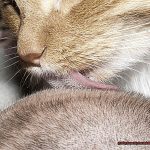Calling all cat lovers. We all know that taking care of our furry friend’s teeth is vital for their overall health. Dental hygiene plays a crucial role in keeping your cat’s teeth clean and healthy, preventing any dental issues from arising. But let’s face it, brushing your cat’s teeth can be a challenging task for many pet owners. So, the question arises – does cat toothpaste work without brushing?
As an expert in feline care, I’ve been asked this question countless times. Some cat owners believe that using toothpaste alone can do the job of cleaning their cat’s teeth and freshening their breath without having to go through the hassle of brushing. Others are skeptical and think it’s impossible. In this blog post, we’ll explore whether or not cat toothpaste works without brushing and discover the best ways to maintain your kitty’s pearly whites.
We’ll take a closer look at the different types of cat toothpaste available on the market, discuss why feline dental health is so important, and delve into some common dental issues that cats face. Plus, we’ll share some tips on how to make toothbrushing less stressful for both you and your feline pal.
So sit back, relax, and let’s uncover the truth about whether or not you can skip brushing with cat toothpaste alone.
Can Cat Toothpaste Work Without Brushing?
Dental hygiene is just as important for cats as it is for humans, and it’s essential to take care of your cat’s teeth to prevent dental diseases. Many cat owners wonder if they can rely solely on cat toothpaste without brushing their cat’s teeth. The answer is no. While cat toothpaste can be helpful, it is not a substitute for brushing.
Cat toothpaste typically contains enzymes and additives that work to break down plaque and tartar buildup on your cat’s teeth. These enzymes can help freshen your cat’s breath and improve their overall oral health. However, without brushing, the toothpaste won’t be able to reach all of the teeth surfaces where bacteria tend to accumulate.
Brushing your cat’s teeth is the most effective way to remove plaque and tartar buildup and prevent dental disease. The mechanical action of brushing helps to physically remove bacteria from the teeth, which cannot be achieved with toothpaste alone. Additionally, brushing can help identify any potential dental problems early on, which can save you money in the long run by avoiding expensive dental procedures.
Of course, brushing your cat’s teeth may seem daunting at first, but it’s essential for their overall health. If your cat is resistant to brushing, try introducing it gradually by starting with just a few seconds of brushing each day and gradually increasing the time as they become more comfortable with the process. You can also try using treats or toys as a distraction during brushing sessions.
Here are some tips to make brushing your cat’s teeth more manageable:
- Choose a soft-bristled toothbrush designed specifically for cats.
- Select a toothpaste flavor that your cat enjoys.
- Start with just a few seconds of brushing each day and gradually increase the duration as they become more comfortable with the process.
- Use treats or toys as a distraction during brushing sessions.
- Be patient and don’t force your cat if they resist.
Benefits of Using Cat Toothpaste
However, their oral health may often be overlooked. Just like us, cats need regular dental care to prevent the buildup of plaque and tartar that could lead to dental diseases and other health issues. Luckily, the solution is simple- using cat toothpaste.
Using cat toothpaste regularly can provide several benefits for your feline companion’s oral health. Here are a few reasons why you should make brushing a part of your cat’s daily routine:
Prevents the buildup of plaque and tartar: Regular use of cat toothpaste helps prevent the buildup of plaque and tartar on your cat’s teeth, reducing the likelihood of dental disease and other oral health issues.
Freshens your cat’s breath: If you’ve ever been close to a cat’s mouth, you know that their breath can be unpleasant. Cat toothpaste can help freshen their breath and make snuggles and cuddles more enjoyable for both you and your furry friend.
Designed specifically for cats: Human toothpaste contains fluoride that can be harmful to cats if ingested in large amounts. Cat toothpaste is formulated with safe and effective ingredients that are tailored to meet the unique needs of felines.
Reduces the need for professional dental cleanings: Regular brushing with cat toothpaste can help remove plaque and tartar before it hardens into calculus, which only a veterinarian can remove through a dental cleaning procedure.
Helps detect potential dental issues early on: By examining your cat’s mouth while brushing their teeth, you may notice signs of dental disease such as redness or inflammation of the gums, broken or loose teeth, or bad breath. Early detection of these issues can lead to prompt treatment and prevent further complications down the line.
Drawbacks of Relying on Cat Toothpaste Alone
However, one aspect of their health that can often be overlooked is dental hygiene. While using cat toothpaste can provide several benefits, relying on it alone as a substitute for brushing can have some significant drawbacks.
Firstly, relying on cat toothpaste alone does not effectively remove plaque and tartar buildup. Plaque is a sticky film that forms on the teeth, containing bacteria that can lead to dental problems such as gingivitis and periodontal disease. Over time, plaque hardens and turns into tartar, which can only be removed by a professional dental cleaning. Using toothpaste alone may help prevent the buildup of plaque but it won’t remove existing plaque or tartar.
Secondly, cat toothpaste cannot address other dental issues that brushing can help prevent. For example, brushing your cat’s teeth can help prevent gum disease, which occurs when bacteria build up under the gumline and cause inflammation. This can lead to receding gums, tooth loss, and even bone loss in severe cases. Toothpaste alone cannot effectively clean under the gumline or remove bacteria.
Moreover, relying solely on cat toothpaste can give pet owners a false sense of security about their cat’s dental health. Using toothpaste may mask bad breath and give the appearance of healthy teeth, but without regular brushing, dental issues may still be present. Dental problems in cats can be extremely painful and even life-threatening if left untreated.
To ensure your cat’s good oral hygiene, brushing their teeth regularly is crucial for removing plaque and tartar buildup, preventing gum disease, and ensuring overall dental health. Remember to consult with your veterinarian for advice on the best products and techniques for your cat’s dental care routine. Here are some tips for incorporating brushing into your cat’s routine:
- Start slowly: Introduce brushing gradually to allow your cat to become comfortable with the process.
- Use a soft-bristled brush: A brush with soft bristles will be gentle on your cat’s gums and teeth.
- Choose the right toothpaste: Make sure to use toothpaste specifically formulated for cats, as human toothpaste can be harmful to them.
- Be patient: Brushing your cat’s teeth may take time and patience, but it’s worth the effort to ensure good dental health.
Tips for Introducing Your Cat to Brushing
Ensuring your cat’s dental health is important for their overall well-being. Introducing your cat to brushing may seem like a daunting task, but with the right approach and some patience, you can make it a lot easier for both you and your feline friend. Here are some tips to help you get started:
Start Slowly
The first step is to introduce your cat to the toothbrush and toothpaste slowly. Let them sniff and taste the toothpaste before you start brushing. This will help them become familiar with the taste and smell of the toothpaste. Once they are comfortable with the toothpaste, move on to gently rubbing it onto their teeth using your finger or a soft cloth.
Use Positive Reinforcement
Reward your cat with treats or praise after brushing. This will help them associate brushing with positive experiences. It will also encourage them to be more cooperative during future brushing sessions. Avoid using punishment or negative reinforcement, as this can cause anxiety and make the process more difficult.
Choose the Right Tools
Make sure to use a soft-bristled toothbrush and toothpaste that is specifically designed for cats. Human toothpaste can be harmful to cats, so it’s important to use products that are safe for them. You can also try using dental wipes or gels if your cat is resistant to using a toothbrush.
Make It a Routine

Set aside a specific time each day for brushing your cat’s teeth. This will help them get used to the routine and make brushing a habit. By sticking to a regular brushing schedule, you can ensure that your cat’s dental health remains in top condition. Make sure to choose a time when your cat is calm and relaxed, such as after a meal or playtime.
Be Patient
It may take some time for your cat to get used to brushing, so be patient and persistent. Start with short brushing sessions and gradually increase the time as your cat becomes more comfortable. If your cat resists or becomes anxious, take a break and try again later. Remember to praise and reward your cat after each successful brushing session.
How Often Should You Brush Your Cat’s Teeth?
Just like us humans, cats can develop dental problems if their teeth and gums are not properly cared for. But how often should you brush your cat’s teeth to prevent future issues?
The general consensus among experts is that you should aim to brush your cat’s teeth at least once a day. Yes, every day. While this may seem overwhelming, establishing this routine early on in your cat’s life is key to preventing any future dental problems.
If your cat is new to tooth brushing, don’t worry – patience is key. Start slowly by introducing them to the toothbrush and toothpaste, allowing them to sniff and taste it before attempting to brush their teeth. Over time, they’ll learn to associate the routine with positive experiences such as treats and cuddles from their favorite human (you.).
But what if your cat simply won’t tolerate having their teeth brushed? Don’t give up just yet. There are other ways to maintain their oral hygiene. Dental treats and chews can help remove plaque and tartar buildup from your cat’s teeth, but be sure to choose products that are specifically designed for cats. Some dental chews may contain ingredients that are harmful to cats, so always read the label carefully before giving them to your pet.
In addition to brushing and dental treats, regular visits to the vet for professional cleanings can also help keep your cat’s teeth healthy. Your vet can perform a thorough cleaning of your cat’s teeth and gums, removing any buildup of plaque or tartar that may have accumulated over time.
Professional Dental Cleanings for Cats
While brushing your cat’s teeth at home is essential, it may not be sufficient to remove all of the plaque and tartar buildup that can lead to dental disease. That’s where professional dental cleanings for cats come in.
Professional dental cleanings are necessary for maintaining good oral hygiene and overall health in cats. Here are some reasons why:
Thorough Examination: During a professional dental cleaning, your cat will be put under general anesthesia to allow for a thorough examination of the teeth and gums. The veterinarian will use specialized instruments to remove any plaque and tartar build-up above and below the gum line. This process ensures that there is no hidden damage or decay that could cause further problems.
Polishing: After removing the plaque and tartar, the veterinarian will polish the teeth to smooth out any rough surfaces that could attract bacteria. By doing so, they reduce the likelihood of bacteria accumulation, which can lead to dental disease.
X-Rays: In addition to cleaning, the veterinarian may also take dental x-rays to check for any underlying issues such as tooth decay or abscesses. If any problems are found, they can be addressed during the same appointment.
Preventative Measures: Regular cleanings can help prevent dental disease, which can lead to more serious health issues such as heart disease and kidney failure. By scheduling annual professional dental cleanings, you can help avoid these severe health risks.
Recommended Frequency: While it is recommended that cats receive professional dental cleanings once a year, some cats may require more frequent cleanings depending on their age and overall health. Your veterinarian will advise you on the best frequency for your cat.
Common Dental Problems in Cats
However, dental health is often overlooked when it comes to our pets. Unfortunately, cats are prone to dental problems that can cause discomfort and pain if left untreated. In this article, we will explore the most common dental issues in cats and ways to prevent them.
Gingivitis
Gingivitis is a condition where the gums become inflamed due to the buildup of plaque and tartar on the teeth. Symptoms include red and swollen gums, bad breath, and difficulty eating. If left untreated, it can progress to periodontal disease, which can lead to tooth loss and bone damage.
Prevention: Regular brushing of your cat’s teeth with a cat toothbrush and toothpaste can prevent the buildup of plaque and tartar.
Periodontal Disease
Periodontal disease is a more severe form of gingivitis that affects the tissues supporting the teeth. It can cause tooth loss, infection, and bone damage.
Prevention: Regular dental check-ups and cleanings by a veterinarian can prevent periodontal disease.
Tooth Resorption
Tooth resorption is a painful condition where the tooth dissolves from the inside out. The cause is still unknown, but it is believed to be related to inflammation or an autoimmune response.
Prevention: Unfortunately, there is no known way to prevent tooth resorption. Regular dental check-ups can help catch this condition early and prevent further damage.
Feline Odontoclastic Resorptive Lesions (FORLs)
FORLs are painful lesions that affect the teeth of cats and are caused by an autoimmune response. Symptoms include difficulty eating and pawing at the mouth.
Prevention: Regular dental cleanings and examinations can help catch FORLs early and prevent further damage.
Tooth Fractures
Tooth fractures can occur due to trauma or from chewing on hard objects. They can expose the sensitive inner parts of the tooth and cause pain.
Prevention: Avoid giving your cat hard toys or bones that can cause tooth fractures.
Ignoring dental problems in cats can lead to serious health issues such as kidney disease, heart disease, and diabetes. Therefore, it is crucial to take your cat for regular dental check-ups and seek treatment if any issues are found.
Signs That Your Cat May Have Dental Issues
Just like humans, cats can suffer from dental issues such as gum disease and tooth decay. And just like with humans, these issues can lead to more serious health problems if left untreated. So, to ensure the well-being of your feline friend, it’s crucial to pay attention to signs that your cat may be experiencing dental issues.
One of the most common signs of dental problems in cats is bad breath. If you notice that your cat’s breath has become particularly pungent, it could indicate bacteria buildup in their mouth, which can lead to plaque and tartar buildup. This issue can cause further dental problems down the line and compromise your cat’s overall health.
Difficulty eating is another sign that your cat may be experiencing dental issues. Dental problems can affect your cat’s ability to chew their food properly, leading them to eat less or lose weight. If you notice your cat struggling to eat or showing signs of weight loss, make sure to schedule a visit with your veterinarian.
Drooling is also a common sign of dental pain or discomfort in cats. Cats may drool excessively when they are in pain or experiencing discomfort in their mouth. Additionally, if you notice your cat pawing at their mouth or face, it could indicate that they are trying to alleviate the discomfort caused by dental issues.
Lastly, bleeding gums can be a telltale sign of gum disease in cats. If you notice blood in your cat’s saliva or on their toys, it’s best to schedule a visit with your veterinarian as soon as possible. Gum disease can cause pain and inflammation and can even lead to tooth loss if left untreated.
Conclusion
In conclusion, while cat toothpaste can aid in maintaining good oral health for your feline friend, it is not a substitute for brushing. The most effective way to prevent dental disease and remove plaque and tartar buildup is by incorporating daily brushing into their routine. Toothpaste alone cannot provide the same level of physical removal of bacteria from teeth that brushing can.
Regular use of cat toothpaste can offer several benefits such as preventing plaque and tartar buildup, freshening breath, and reducing the need for professional cleanings. However, relying solely on toothpaste without brushing can lead to significant drawbacks as it does not address existing dental issues or effectively remove plaque or tartar buildup.
To ensure your cat’s optimal oral hygiene, consistent brushing is crucial for removing plaque and tartar buildup, preventing gum disease, and promoting overall dental health. Consult with your veterinarian for advice on the best products and techniques tailored to your cat’s needs.
Pay attention to signs of potential dental issues such as bad breath, difficulty eating, drooling, bleeding gums or pawing at their mouth or face. Dental problems in cats are painful and can be life-threatening if left untreated.







